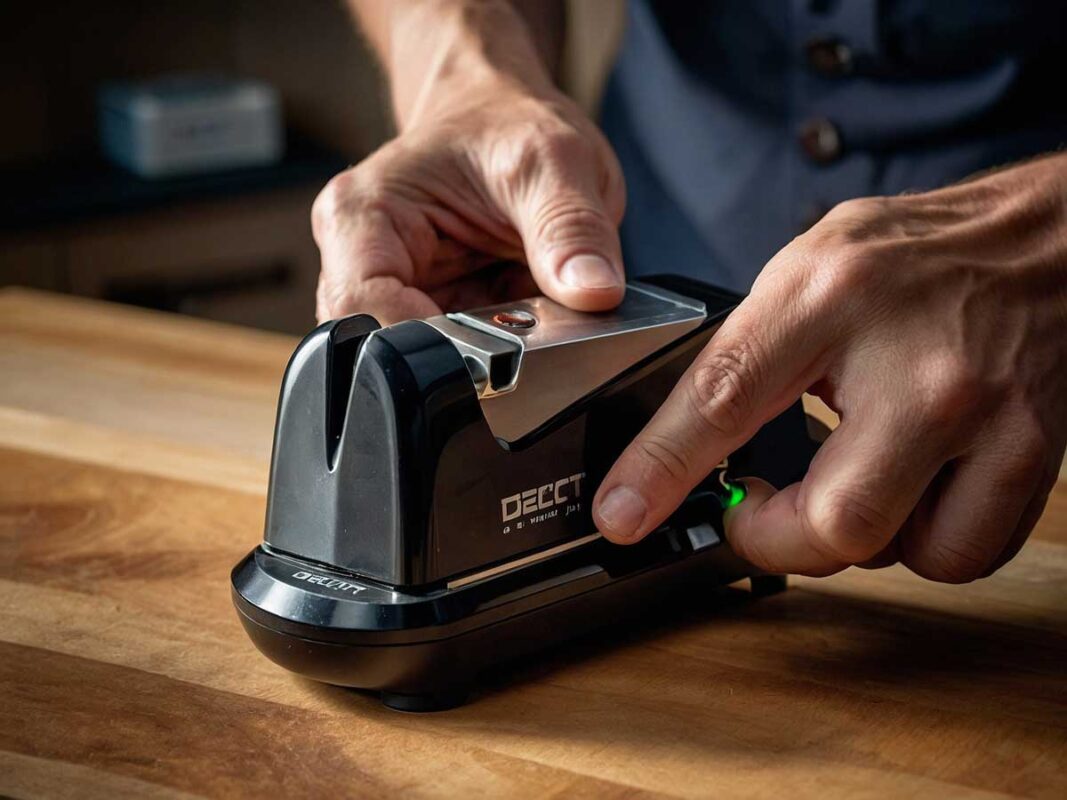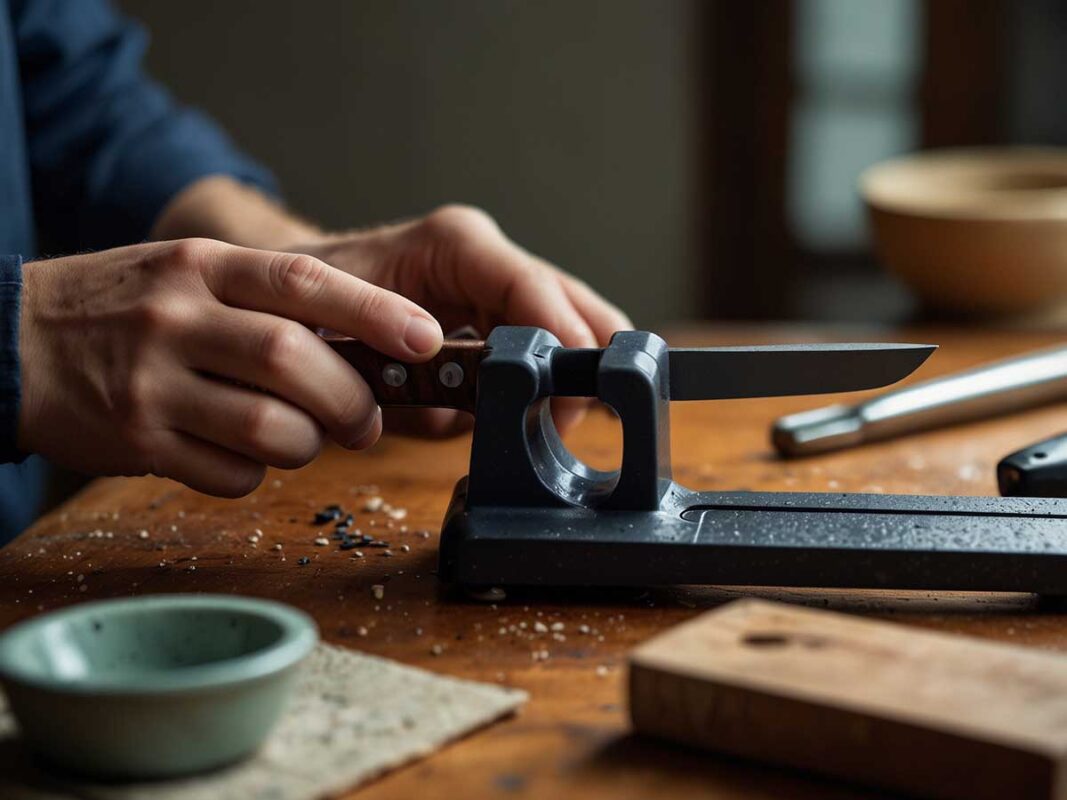How Can You Sharpen Ceramic Knives Safely and Effectively?

To sharpen ceramic knives is a task many knife enthusiasts and chefs find challenging. Ceramic knives, known for their sharpness and longevity, offer excellent benefits. They maintain their edge longer than steel knives and resist rust.
However, the main challenge is sharpening ceramic blades due to their brittle nature. While they excel in cutting performance, their hardness makes them prone to chipping and breakage if not handled correctly. Let’s learn how to sharpen ceramic knives effectively.
Understanding Ceramic Knives
Ceramic knives are made from zirconium dioxide, also known as zirconia. This material gives them unique properties compared to steel knives. One of the primary ceramic knife benefits is their hardness.
They are significantly harder than steel knives, which means they retain their sharp edge for a much longer time. Additionally, ceramic knives are lightweight and highly resistant to rust, making them an attractive choice for many users. However, these ceramic knife properties also make them more brittle, requiring careful handling and specialized sharpening techniques.
Methods to Sharpen Ceramic Knives Safely
Using a Diamond Stone

Sharpening ceramic knives with a diamond sharpening stone is effective if done carefully. Here’s a step-by-step guide:
- Choose the Right Diamond Stone: Ensure it’s designed for hard materials.
- Set the Correct Angle: The optimal angle for sharpening ceramic knives is between 15-20 degrees. This helps maintain the edge without causing damage.
- Wet the Stone: Lightly moisten the diamond stone to reduce friction and remove debris.
- Secure the Knife: Hold the knife firmly but do not apply excessive force. Use a gentle grip to avoid chipping.
- Sharpen with Gentle Strokes: Move the knife across the stone in smooth, controlled strokes. Start from the base of the blade and move towards the tip. Keep a consistent angle.
- Check Progress Regularly: Inspect the edge frequently to avoid over-sharpening.
- Clean the Knife and Stone: Wipe the blade and stone clean after sharpening to remove any residue.
Sharpening with a diamond stone requires patience and precision. Always use light pressure to avoid chipping the brittle ceramic material.
Using an Electric Sharpener

An electric knife sharpener for ceramic knives can simplify the sharpening process. Here’s how to use one effectively:
- Select a Suitable Sharpener: Make sure it’s specifically designed for ceramic knife electric sharpening.
- Read the Instructions: Each model might have specific guidelines. Familiarize yourself with them before starting.
- Prepare the Knife and Sharpener: Ensure both are clean. Set up the sharpener on a stable surface.
- Insert the Knife: Gently place the knife into the designated slot, usually marked for ceramic blades.
- Sharpen in Controlled Intervals: Turn on the sharpener and draw the knife through the slot slowly. Let the machine do the work. Avoid applying extra pressure.
- Repeat if Necessary: Depending on the blade’s condition, you might need a few passes to achieve the desired sharpness.
- Safety First: Always keep your fingers clear of the blade and sharpener slots. Follow the safety tips provided by the manufacturer.
While using an electric sharpener is convenient, it’s essential to handle the process with care to prevent any damage to your knife.
Professional Sharpening Services

Sometimes, the best option for sharpening your ceramic knives is to use professional knife sharpening services. Here’s why and when to consider this:
- Precision and Expertise: Professionals have the tools and experience to sharpen ceramic knives accurately, ensuring the edge is restored without causing chips or cracks.
- Convenience: If you lack the time or confidence to sharpen the knife yourself, a professional service can be a reliable choice.
- Avoiding Damage: Proper sharpening requires skill, especially with ceramic blades. Professionals minimize the risk of damaging the knife.
- Additional Services: Many professionals offer ceramic knife repair services that can fix minor damages and maintain the overall quality of the knife.
Considering professional services can save you time and ensure your ceramic knives are sharpened to perfection.
Learn more: How to Sterilize a Knife at Home and Outdoors
Maintenance Tips for Ceramic Knives
Maintaining ceramic knives properly can extend their sharpness and lifespan. Here are some ceramic knife care tips to keep them in top condition:
Proper Cleaning:
- Wash your ceramic knives by hand using mild soap and warm water.
- Avoid using abrasive scrubbers that can scratch the surface.
- Dry the knife thoroughly with a soft cloth to prevent water spots.
Correct Storage:
- Store ceramic knives in a knife block, sheath, or on a magnetic strip to avoid contact with other utensils.
- Ensure the storage method protects the blade from any impact that could cause chipping.
Cutting Surface:
- Always use a soft cutting board, such as wood or plastic. Avoid hard surfaces like glass or granite that can damage the blade.
Foods to Avoid:
- Refrain from cutting hard or frozen foods, bones, and pits. These can cause the blade to chip or crack.
- Use ceramic knives primarily for fruits, vegetables, boneless meats, and other softer foods.
By following these maintaining ceramic knives tips, you can enjoy the benefits of your ceramic knives for a longer period.
Benefits and Drawbacks of Ceramic Knives
Understanding the ceramic knife pros and cons can help you decide if they are the right choice for your needs. Here are the main advantages and disadvantages:
Benefits
Sharpness: Ceramic knives maintain their sharp edge much longer than steel knives. They can go months without needing sharpening.
Rust Resistance: Since ceramic knives are made from zirconium dioxide, they are completely resistant to rust and corrosion. This makes them ideal for humid environments and frequent use with acidic foods.
Lightweight: These knives are significantly lighter than steel knives, reducing hand fatigue during prolonged use.
Drawbacks
Brittleness: The hardness that gives ceramic knives their sharpness also makes them brittle. They can chip or break if dropped or used on hard foods.
Difficulty Sharpening: Sharpening ceramic knives requires specialized tools and techniques. Standard knife sharpeners and stones are usually ineffective.
Limited Versatility: Because of their brittleness, ceramic knives are not suitable for all tasks. They are best for specific uses like slicing fruits, vegetables, and boneless meats.
By weighing these ceramic knife advantages and disadvantages, you can determine if they fit your kitchen or outdoor needs.
Frequently Asked Questions (FAQs):
Bottom Lines
Sharpening ceramic knives can be a bit challenging, but it’s definitely possible with the right tools and techniques.
Using a diamond stone or an electric sharpener designed for ceramic blades ensures good results.
Proper ceramic knife maintenance—like cleaning by hand, storing correctly, and avoiding hard foods—helps keep the edge sharp longer.
Remember, if you’re unsure, professional services can offer precision sharpening.
By following these steps, you can maintain the sharpness and longevity of your ceramic knives.
Happy cutting!
